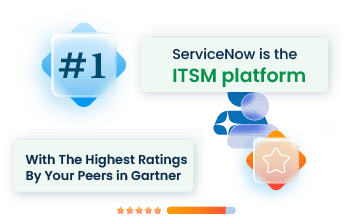“ServiceNow integration with Jira addresses many pain points professionals face, such as disjointed workflows, manual data entry, and fragmented communication. These challenges often lead to delays, errors, and frustration. By integrating these platforms, you can create a seamless flow of information, enhancing collaboration and productivity.
This integration automates ticket synchronization between ServiceNow and Jira, reducing manual effort and minimizing errors. Teams can work within their preferred platforms while staying aligned on tasks and updates. It streamlines incident management, change requests, and service requests management, providing a unified approach to handling IT and business processes.
Benefits of Jira ServiceNow Integration
For Jira Users:
- Task Simplification: Integration reduces manual entry, ensuring tasks automatically sync between Jira and ServiceNow. This minimizes errors and saves time, allowing your team to focus on high-priority tasks.
- Improved Workflow: Seamless sync allows for smooth transitions from task creation to resolution. Your team stays informed without switching platforms, boosting overall productivity.
For ServiceNow Users:
- Incident Management: Integration ensures incidents logged in ServiceNow appear in Jira, streamlining the resolution process. This leads to quicker response times and enhanced service quality.
- Service Request Handling: Requests in ServiceNow sync with Jira, allowing for unified management. This provides a comprehensive view of tasks and their statuses, reducing confusion and improving coordination.
Enhanced Collaboration:
- Real-Time Updates: Changes in one system reflect immediately in the other, keeping all team members on the same page.
- Two-Way Communication: Both platforms communicate bidirectionally, ensuring consistent information flow and reducing misunderstandings.
Scalability and Customization:
Bulk Operations: Handle multiple tasks at once, whether updating statuses or synchronizing data, making large-scale changes manageable.
Custom Functions: Tailor the integration to fit specific workflows and business requirements, providing flexibility and control.
Security and Compliance:
- Data Integrity: Robust security measures protect data integrity during sync, ensuring sensitive information remains secure.
- Compliance Alignment: Integration aligns with industry standards, aiding in maintaining regulatory compliance.
Key Features of Jira ServiceNow Integration
Bi-directional Sync
Let’s assume a seamless flow of information between Jira and ServiceNow. Bi-directional sync keeps both platforms updated in real-time. Changes in Jira reflect instantly in ServiceNow and vice versa.
This sync eliminates manual data entry, reducing errors and boosting productivity. Having incident updates in Jira that mirror ServiceNow’s without delay, providing your team with accurate and up-to-date information.
Incident Management and Bug Tracking
Integration transforms how you handle incidents and bugs. With both systems communicating smoothly, tracking and resolving issues becomes straightforward.
Incidents logged in ServiceNow appear in Jira, allowing your IT and development teams to collaborate effortlessly. This streamlined process leads to quicker resolutions, fewer backlogs, and happier stakeholders.
Automated Integration
Automation stands at the core of this integration. Routine tasks like data syncing and incident creation no longer require manual intervention.
Automation speeds up processes, minimizes human error, and allows your team to focus on higher-value tasks. Think about the time saved when workflows execute without constant oversight.
Better Scalability and Top-notch Security
Handling large data volumes without compromising security is crucial. This integration supports scalability, accommodating growing data and user demands.
Security features safeguard sensitive information during transfers. Robust encryption and access controls provide peace of mind, knowing your data remains protected.
Step-by-Step Guide to Setting Up Jira ServiceNow Integration
Install the Necessary Apps
To kick off the integration, start by installing the integration app (Exalate, OpsHub, or ZigiOps) on both Jira and ServiceNow instances.
In Jira, navigate to the Atlassian Marketplace and locate integration app (Exalate, OpsHub, or ZigiOps). Click ‘Install’ and follow the prompts.
In ServiceNow, head to the ServiceNow Store, search for integration app (Exalate, OpsHub, or ZigiOps), and proceed with the installation.
Screenshots or video tutorials can greatly assist in this step, offering clear visual guidance.
Establish a Connection
Once the apps are installed, establishing a connection between Jira and ServiceNow forms the next step.
Open theintegration app (Exalate, OpsHub, or ZigiOps) in Jira and click on ‘Connections’. Opt for ‘New Connection’ and pick ‘ServiceNow’ as the target.
You will receive an invitation code. In ServiceNow, open the integration app (Exalate, OpsHub, or ZigiOps), go to ‘Connections’, and use the received invitation code to accept the connection.
This process ensures both platforms communicate seamlessly.
Configure Synchronization Triggers
Synchronization triggers dictate when and what data synchronizes between the two systems.
In Jira, navigate to integration app (Exalate, OpsHub, or ZigiOps) and select ‘Triggers’. Create a new trigger by defining the conditions under which data should sync (e.g., when a new issue is created or updated).
These triggers ensure the right data flows at the right time, keeping both systems aligned.
Mapping Fields and Data
Proper field mapping is crucial for data consistency between Jira and ServiceNow. In Jira, within the integration app (Exalate, OpsHub, or ZigiOps), go to ‘Mappings’.
Define how fields in Jira correlate with those in ServiceNow. For example, map Jira’s ‘Summary’ field to ServiceNow’s ‘Short Description’.
This step guarantees that data remains accurate and coherent across both platforms, resolving issues like mismatched fields and data loss.
Advanced Configuration Options
Custom Functions and Scripting
Tailoring your integration to specific business needs requires more than just a basic setup. With custom functions and scripting, you can fine-tune the integration between Jira and ServiceNow to match your unique workflows. Whether automating complex processes or adding custom fields, scripting provides the flexibility needed to make the integration work seamlessly for your organization. This approach ensures that your systems communicate exactly as required, addressing specific requirements without compromise.
Bulk Operations and Scalability
Handling large volumes of data efficiently is crucial for businesses dealing with extensive records. Bulk operations allow you to process significant data sets in one go, saving time and reducing manual effort. This capability means your integration can scale as your business grows, managing increasing amounts of data without performance issues. By optimizing bulk operations, your integration remains robust and responsive, catering to the demands of a growing enterprise.
Decentralized Integration and Security
A decentralized approach to integration offers enhanced security and autonomy. This method distributes integration tasks across different systems, reducing the risk of a single point of failure. Each part of your system works independently but in harmony, providing a resilient setup. Security remains a priority, with decentralized integration ensuring that sensitive data stays protected and compliance requirements are met. This setup allows for secure communication and data transfer between Jira and ServiceNow, giving you peace of mind.
Content Gap Analysis and Optimization
After a thorough review of competitor content, it becomes clear that many lack depth in explaining the technical details and practical applications of advanced configuration options. Our content addresses this by providing in-depth explanations and actionable insights that go beyond surface-level information.
Competitors like OpsHub and ZigiWave provide basic outlines but often skip detailed customization steps and the technical intricacies of scripting and bulk operations. For instance, OpsHub’s content lacks comprehensive guidance on handling large data volumes, while ZigiWave does not sufficiently cover security aspects in decentralized integrations.
Use Cases for Jira and ServiceNow Integration
Syncing ServiceNow Change Requests with Jira Issues
Integration between ServiceNow and Jira streamlines the process of managing change requests. When a change request in ServiceNow syncs with an issue in Jira, teams can track and resolve issues without switching platforms.
This setup ensures that updates in one system reflect in the other, keeping both IT and development teams aligned. When a change request gets updated in ServiceNow, the corresponding Jira issue updates automatically. This synchronization reduces manual effort and errors, making issue resolution faster and more reliable.
Prioritizing and Handling Customer Incidents
Integrating these platforms helps prioritize and handle customer incidents more effectively. ServiceNow’s incident management pairs with Jira’s issue tracking to ensure incidents receive timely responses.
When a high-priority incident gets logged in ServiceNow, it syncs to Jira, allowing development teams to address the problem promptly. This integration means both IT and development teams stay informed and can collaborate better on resolving critical issues, improving response times and customer satisfaction.
How Integration Has Helped Businesses Manage Incidents More Efficiently
Businesses see substantial improvements in incident management with this integration. One company reported handling around 500 customer incidents per week due to faster synchronization, much quicker than their previous solution.
By syncing data between ServiceNow and Jira, teams access the latest information, reducing the time taken to resolve incidents. This approach leads to better service delivery and customer experiences.
Create Jira Issue/Task and Update ServiceNow Incident
With the integration in place, creating a Jira issue or task from a ServiceNow incident becomes straightforward. When a ServiceNow incident gets logged, it can automatically create a corresponding Jira issue or task.
This functionality ensures that tasks receive attention from the right team without any delays. Updates in Jira automatically reflect in ServiceNow, providing a unified view of progress and status. This seamless flow of information helps in maintaining transparency and accountability across teams.
Challenges Faced by Jira and ServiceNow Users
Integrating Jira and ServiceNow brings numerous benefits, yet it also introduces some challenges. Addressing these challenges head-on helps create a seamless experience. Here are some of the common issues and how to resolve them:
1. Data Synchronization Issues Ensuring data consistency between Jira and ServiceNow can be tricky. One common problem is mismatched fields or incomplete data transfers.
Define and map fields accurately in both systems. Regularly check synchronization logs to identify and resolve any discrepancies immediately.
2. Performance Bottlenecks High volumes of data can slow down the integration process, affecting performance. This can lead to delayed updates and frustrated users.
Optimize data transfer processes by filtering out unnecessary information. Consider batch processing for large datasets to maintain performance.
3. Security Concerns Data security during integration raises concerns, especially when dealing with sensitive information.
Implement robust encryption protocols and access controls. Regularly update and audit security settings to maintain a secure integration environment.
4. User Training and Adoption Users might struggle with the new integrated system, leading to decreased productivity.
Provide comprehensive training sessions and create detailed user guides. Encourage feedback and offer ongoing support to ensure smooth adoption.
5. Customization Challenges Integrating two complex systems like Jira and ServiceNow often requires customization, which can be complex and time-consuming.
Use a flexible integration platform that allows for easy customization. Engage with experienced consultants or integration experts to streamline the customization process.
Best Practices for a Smooth Integration
1. Clear Objectives and Planning Define clear goals for the integration project. Know exactly what you want to achieve and plan accordingly. This reduces scope creep and helps keep the project on track.
2. Regular Testing and Validation Regular testing ensures that the integration works as intended. Validate data transfers and system interactions frequently to catch and resolve issues early.
3. Continuous Monitoring and Maintenance Ongoing monitoring of the integration ensures long-term success. Use monitoring tools to track performance and address issues promptly. Schedule regular maintenance to keep the systems updated and functioning smoothly.
Conclusion
Integrating ServiceNow with Jira transforms your operations by connecting IT service management with agile project management.
With this integration, incident reports automatically link to relevant Jira issues, simplifying workflows and allowing your team to focus on resolving issues.This fosters collaboration between IT and development teams, leading to faster incident resolution and improved service delivery.
Consider reaching out for a Servicenow Consultation. Our experts can guide you through the setup process, tailoring the integration to your needs. By connecting with us, you take a step toward a unified and productive work environment, solving your operational challenges through robust integration.













